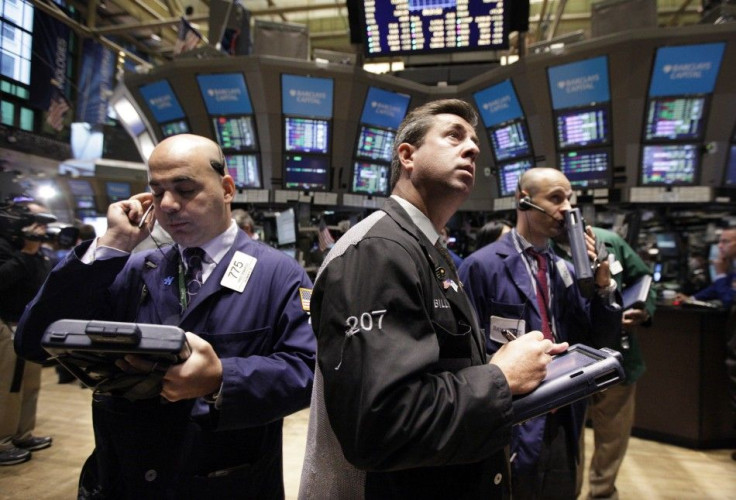U.S. Stocks: Dow Plunges 240, Market Posts Worst Quarter Since 2008

To say that the U.S. stock market had a rough quarter would be like saying invading Germany had a rough retreat from Stalingrad in the winter of 1943 -- stocks closed near session lows Friday, a down day that meant all three major averages plummeted more than 10 percent in the third quarter.
What's more, it was the worst quarterly performance for the indices since the financial crisis started in 2008 -- and it's the first time all three indices have registered a double-digit decline since the financial crisis' acute stage in late 2008.
On Friday, the Dow Jones Industrial Average (DJIA) closed down 240 points 10,913, the Nasdaq sank 65 points 2,415, and the S&P 500 plunged 29 points to 1,131.
For the third quarter, the Dow lost 11 percent, the Nasdaq dropped 12 percent, and the S&P 500 500 sank 13 percent.
Economy Is Weak, Market Is Weak
The market has really seen some damage this quarter, said Mike Hurley, portfolio manager of Highland Trend Following Fund, told The Associated Press Friday. Lower interest rates and commodity prices are definitely an indication that the market thinks economic activity is going to be weak.
The Dow's third quarter close-out session became a bear raid -- or a session when the institutional investors who sold stock prevailed -- even though one important economic data point released Friday was positive: manufacturing activity in the Chicago region expanded at a more rapid pace, rising to 60.4 in September from 56.5 in August.
The above stock index stats do detail a read-it-and-weep story for investors, but if casual observers are convinced the third quarter has spelled the end of stock gains for awhile, their judgment is premature: Wall Street remains in a classic bull/bear fight -- and the bulls have hardly given up.
Bulls, Bears Battle Hasn't Been Resolved, Yet
The market's bulls -- those who say the Dow is headed higher -- argue that despite the fact that the U.S. economy grew at a very low 1.3 percent rate in the second quarter, private sector lay-offs most likely have peaked, auto sales are still trending up, exports remain adequate and there are signs that corporations may be willing to deploy capital for new projects. Ford (F), for example said this week it remains committed to adding 10,000 new employees, including 7,000 over the next two years.
Conversely, the market's bears -- those who say the Dow will decline -- argue the substantially smaller U.S. workforce, stagnant income in many job classifications, an economy that's short -- at minimum -- about 11 million full-time jobs, that ongoing consternation known as Europe government bonds, or sovereign debt -- and the U.S. Federal Reserve's status quo Operation Twist monetary policy still leave a U.S. economy that's short aggregate demand.
Technical Analysis: Mixed Signals
From a technical standpoint, the Dow has surrendered the psychologically-significant 11,000-level -- an accomplishment the bears tout -- and is well below the key, 50-day moving average, which is 11,393, and the even-tougher-to-break 200-day moving average, at 11,984.
The above would suggest that there's more downside ahead for the Dow and the market, but there are technical indicators that critique the above.
The bulls point to the fact that although the Dow recorded a horrible decline during the quarter amid a stream of economic data that confirmed slower U.S. GDP growth, the Dow has failed to fall through key technical support at 10,760 and 10,700.
In other words, sustained selling for roughly two months has failed to drive the Dow below a support level that would likely trigger more losses -- and the bulls point to this as a technical support sign that suggests the Dow's down-trend is coming to an end. Sell more now, at your own peril, bears, the bulls say.
What's more, the MAC Histogram has shown a lack of selling pressure for about three weeks -- another sign, the bulls argue, that the Dow is forming a bottom at/near that aforementioned key technical support at 10,760 and 10,700.
Market/Economic Analysis: So with the technical indicators mixed, where is the Dow headed, as the fourth quarter starts?
Obviously, a lot will hinge on the U.S. economic data reported during the next three months and there is no fundamental data point more important than the monthly U.S. report, formally the U.S. Department of Labor's Non-Farm Payroll Report.
If the report -- and September's data will be released Friday Oct. 7 at 8:30 a.m. EDT -- shows that the U.S. economy is creating at least 125,000 to 150,000 jobs per month, it will be advantage bulls.
However, if job growth continues to underperform -- with the economy creating less than 100,000 jobs per month -- that would be touted by the bears that their thesis that a double-dip recession is ahead is closer to the truth than the bulls' argument that the economic expansion is set to re-accelerate.
Of course, quarterly earnings by large cap and S&P 500 companies will also be closely scrutinized by the market, but institutional investors know what will truly drives the market: workforce expansion, i.e. job growth. Good things happen to earnings and to U.S. GDP, and by extension, to the Dow, when jobs are being added at a healthy rate; the reverse, bad things.
So keep your eye on how many jobs the U.S. created in September for the next clue as to where the economy, and the Dow, are headed.
© Copyright IBTimes 2024. All rights reserved.











